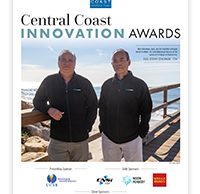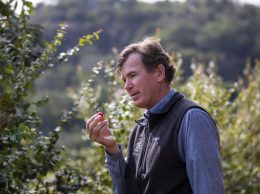Denver-based oil company Venoco believes it can draw an additional 60 million barrels of oil from wells already in place on Platform Holly in the Santa Barbara Channel. It just has to drill deeper.
The wells would also extend into portions of the South Ellwood Oil Field, where Venoco’s lease with the California State Land Commission doesn’t.
Venoco submitted the project application to the commission in April 2014. The application was deemed complete in September 2014 and the environmental impact report process began in January. In the run-up to a possible approval, the commission is holding a public meeting to receive comment on the scope of an EIR in Goleta on May 26.
While Santa Barbara County, the city of Santa Barbara and the city of Goleta all have some skin in the game when it comes to potential impacts of the project, Venoco isn’t required to seek approval from them.
Venoco Executive Chairman Tim Marquez told the Business Times that his company’s drilling will have limited impact on the local marine environment. “Look at our environmental track record,” he said. “We’ve been rated one of the best operators in federal waters … All the oil not produced here is going to be produced somewhere else and imported. Let us just produce it here for the next 25 to 30 years and then get the hell out of here.”
In an effort to garner support from the three-member commission, Venoco is proposing to quitclaim portions of its current lease to the state to offset a lease line adjustment that would give the company rights to drill into a 3,400-acre area east of the platform. The company would give up about 3,800 acres.
However, the major lynchpin in the project company officials are pushing is a reduction in greenhouse gas emissions that would result from increased oil production at Platform Holly.
With one of the most prolific natural oil and gas seeps in the world bubbling up from the sea floor in the Santa Barbara Channel, beach tar is likely to always be a part of the coast landscape. But the bigger problem is the amount of carbon dioxide and methane gas emissions escaping into the local environment.
According to Santa Barbara County’s Air Pollution Control District, seeps in the channel account for roughly 700,000 tons of carbon dioxide equivalent emissions per year and about 20 percent of the total reactive organic compounds, essentially ozone pollution, released in the county.
Over the years, seep activity has slowed and even stopped in some areas of the channel. Citing UC Santa Barbara research, Venoco is claiming some responsibility for the seep reductions and leveraging the information to gain support for the new project.
The most recent studies from UCSB, conducted by professor James Boles, suggest the seeps within one mile of Platform Holly have been reduced by 80 percent since production started. According to the company, extending the six wells into the active seep area could reduce carbon emissions, including potent methane gas, by about 350,000 tons per year. Venoco said that’s equivalent to removing about 75,000 vehicles from California roads.
According to Boles’ report, a large quantity of hydrocarbon is being released from the proposed development area. One of the seep tents, a mechanism that captures oil and gas, installed it on the site in 1982 by ARCO has captured on average 672 million cubic feet per day until all seepage stopped in 2013. In terms of the seep tent gas capture, the amount of gas seeping in the undeveloped area is estimated to be 2.5 to 6 times greater. It is difficult to determine with accuracy, what fraction of this seepage would be removed by producing the underlying hydrocarbons in this area. It is reasonable, however, to assume that the effect will be significant based on the data and trends observed under previous production leases, the report states.
Venoco, which has struggled with debt issues due to the collapse in oil prices, is also quick to tout the economic benefits of the project. According to the company, the project would generate up to $10 million in annual incremental property taxes for the county, which would be designated to local schools and public safety. On top of that, the state would receive an estimated $45 million annually in incremental production royalties. Venoco’s project description also suggests potential for local revenue sharing.
The company expects the final EIR and project approval to be considered by the State Lands Commission in the first quarter of 2016. If approved, drilling on the first of the six wells would start in 2017, with production starting later that year.
Since the early 1990s, both ARCO and Mobil have tried and failed to get major oil producing projects approved for the same area Venoco is aiming to tap further. Marquez said this project is part of a plan that was broken into three more manageable parts.
Since the crash in oil prices, Venoco hired Blackstone Capital to help the company restructure its debt. To do that, the firm has been selling off assets and buying back a lot of its debt on the cheap. To keep shedding debt, the company has a plan to continue to buy back its bonds, make acquisitions in existing fields and develop them further. Marquez said the company is well hedged through 2016 and is working on 2017. Beyond that, Venoco is charting an unpredictable future and will have to increase liquidity to survive. The company is cash flow positive, “but it’s not huge,” Marquez said.
The project on Platform Holly is just one of the company’s efforts to improve that line. The total project cost is estimated to be about $150 million to $175 million to complete.
“If anyone is willing to listen to us, producing more oil from Platform Holly is going to reduce greenhouse gas emissions,” he said. “If logic prevailed in California, it would be a 10-minute meeting. If we don’t get this, it’s a lose-lose.”






 Print
Print Email
Email

















